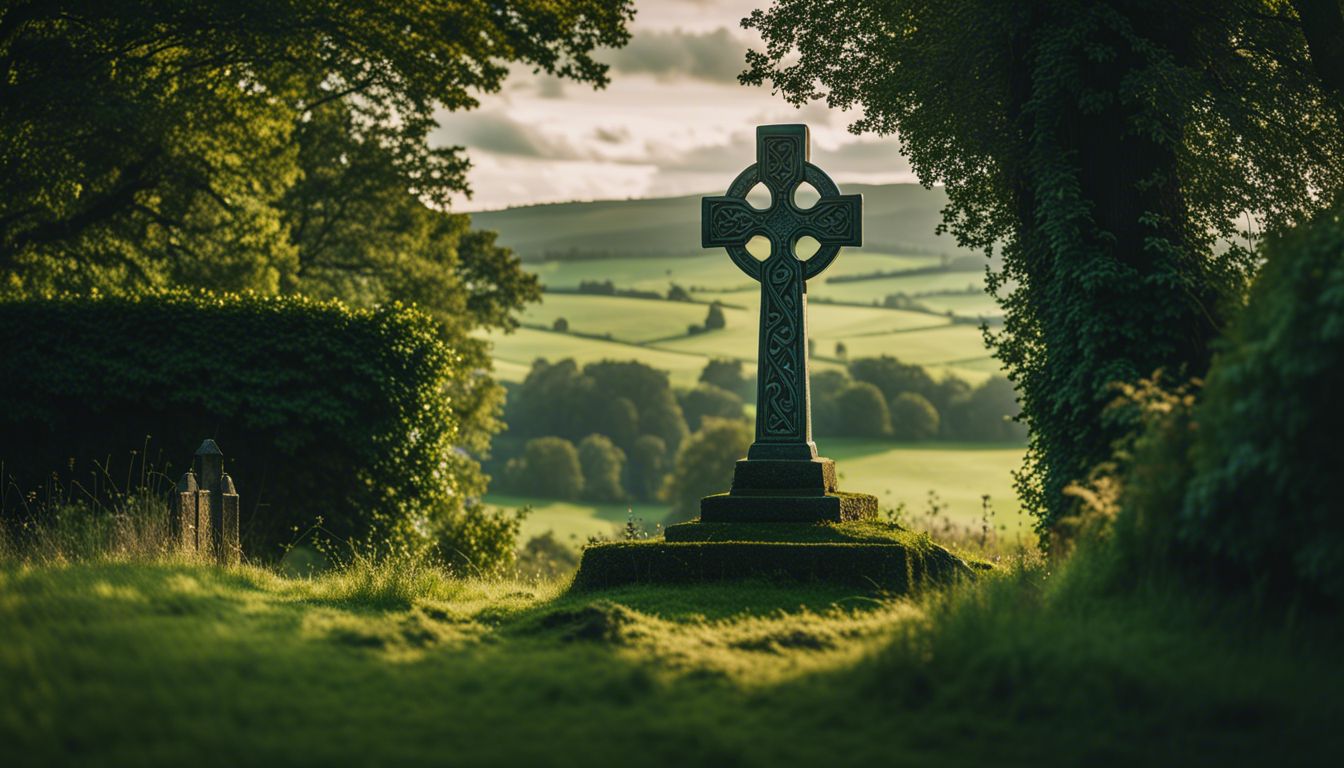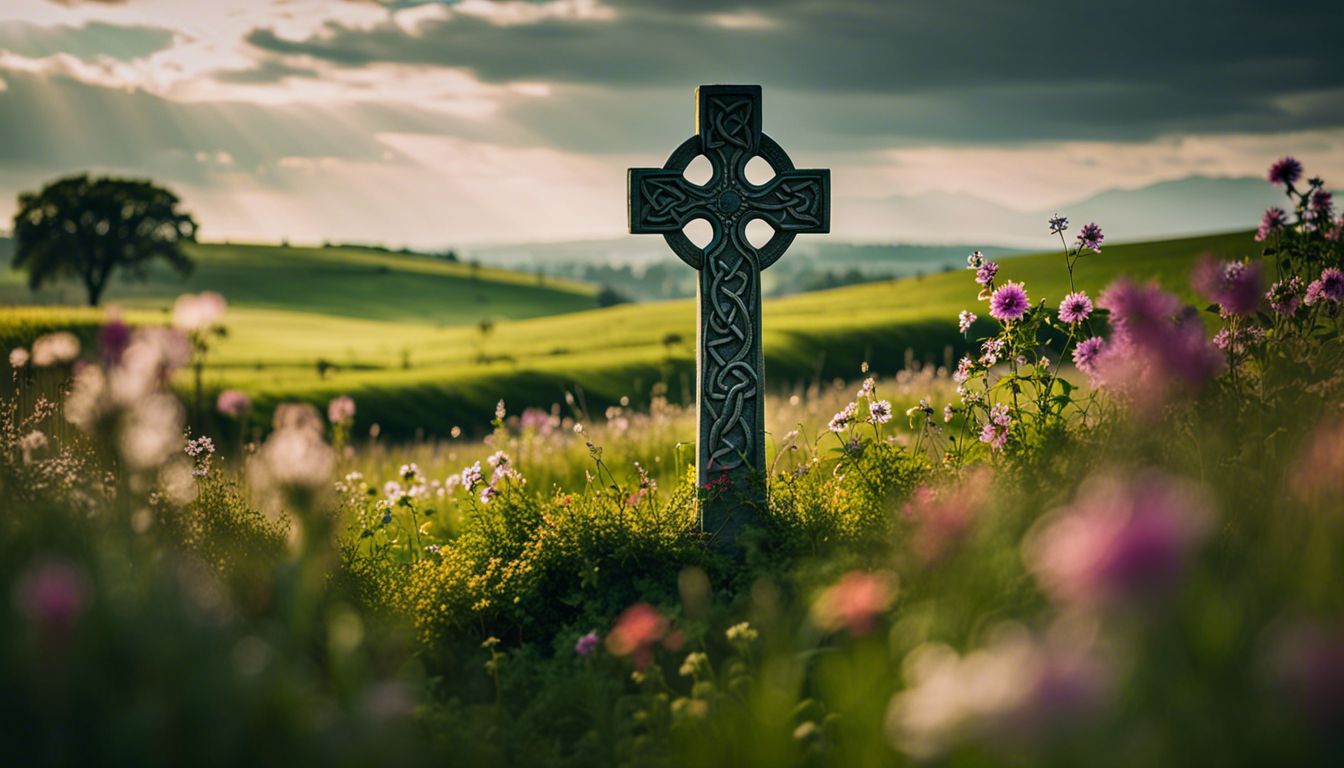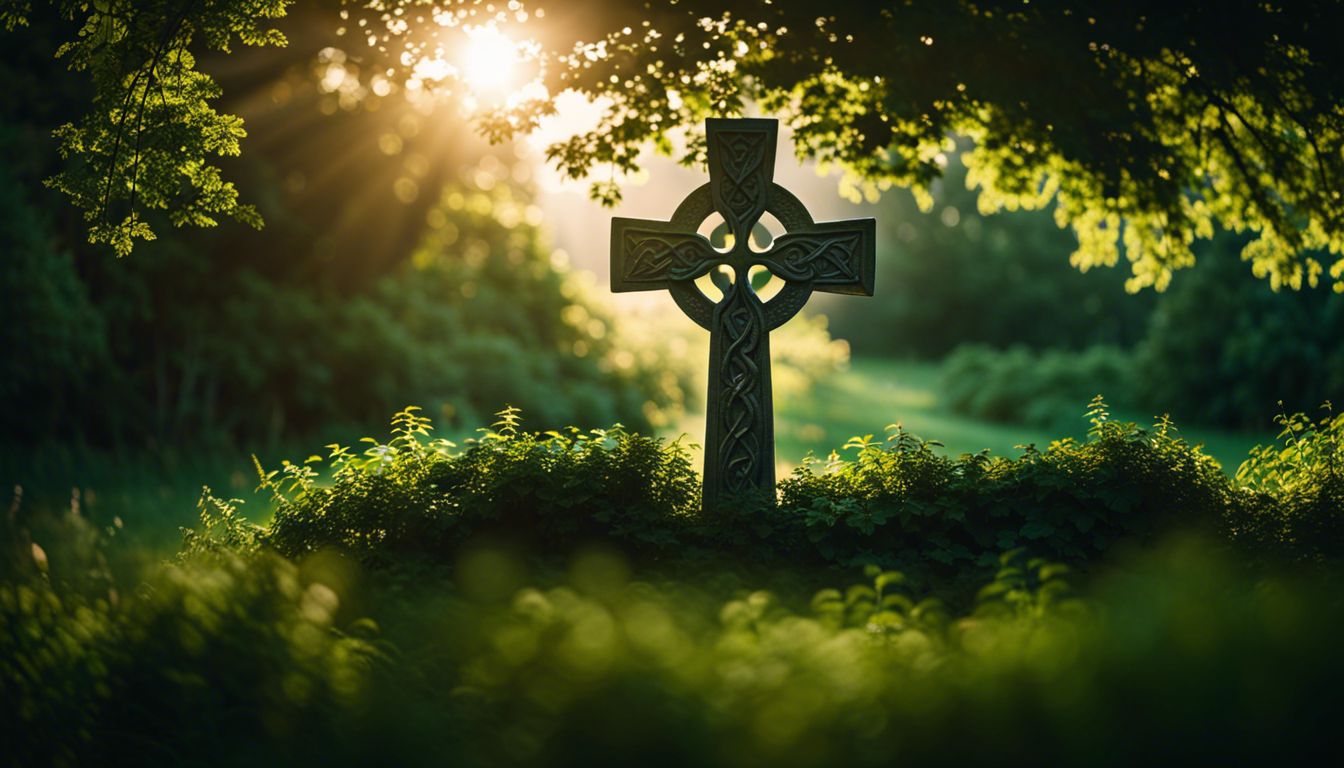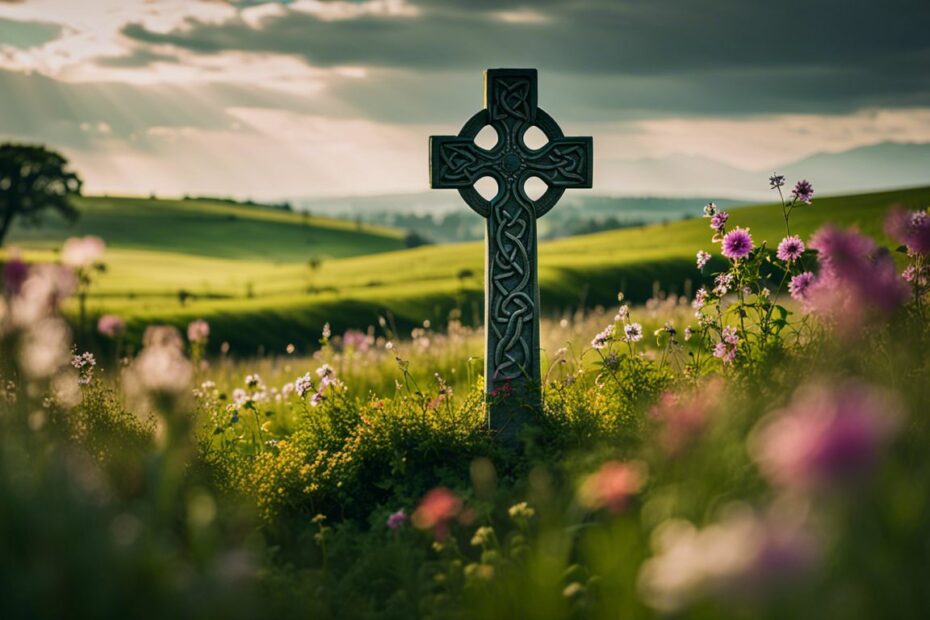Are you curious about the spiritual meaning behind the lively celebration we know as St. Patrick’s Day? This holiday commemorates the life and work of St. Patrick, who is credited with bringing Christianity to Ireland over 1500 years ago.
As we dive deeper into this topic, you will uncover not only the historical significance but also how various symbols associated with this day – shamrocks, rainbows, even green beer – resonate deeply within our soul journey.
Prepare for a fascinating exploration that brings renewal and growth amidst the clovers and leprechauns!
The Life and Legacy of St. Patrick

St. Patrick, the patron saint of Ireland, had an incredible life and left behind a powerful legacy that continues to be celebrated on St. Patrick’s Day.
Early Life and Conversion
Born in Roman Britain during the late 4th century, St. Patrick experienced a life-altering event at age 16 – Irish pirates kidnapped him and took him to Ireland as a slave. This harsh period served as an awakening for his spiritual journey, leading him to embrace Christianity wholeheartedly.
After six years of servitude, he managed to escape, but Ireland had left an indelible mark on his spirit. Driven by visions and a profound calling, St. Patrick returned purposefully to the land of his captivity with one goal — spreading Christianity among its people.
Mission and Spread of Christianity
St. Patrick’s unyielding drive to spread Christianity across Ireland became his life mission after escaping from Irish pirates who had kidnapped him during his early years. This spiritual pursuit marked a significant turning point in the conversion of the island, where predominantly Irish pagans resided at that time.
Acknowledged as the patron saint of Ireland, St. Patrick employed creative and relatable metaphors like the three-leaved shamrock to illustrate complex Christian concepts such as the Holy Trinity to potential believers.
His zealous evangelism initiated a wave of transformation not just within individuals but also throughout communities, leading to notable growth in Christian followership across Ireland.
Today, honoring St.Patrick’s Day symbolizes celebrating this impactful journey of faith propagation undertaken by St.Patrick and cherishing its profound legacy on Irish culture and spirituality.
Spiritual Symbolism of St. Patrick’s Day

The shamrock holds spiritual symbolism on St. Patrick’s Day, representing the Holy Trinity in Christian faith.
The Significance of the Shamrock
The shamrock, with its three leaves, holds a central role in the celebration of St. Patrick’s Day. It was masterfully utilized by St. Patrick himself as he sought to explain the complex concept of the Holy Trinity – Father, Son and Holy Spirit – to Irish pagans during his mission.
This simple plant also symbolizes key virtues: faith, hope, and love in Irish spirituality. Beyond religious teachings, it’s seen as a good luck charm and is often worn or displayed on this day across various cultures worldwide.
Furthermore, green color ties up with it representing growth, fertility and vitality aligning perfectly well with nature’s resurgence in spring when St.Patrick’s Day is celebrated.
The Role of the Green Color
The color green holds significant symbolism on St. Patrick’s Day, representing both the natural beauty of Ireland and the hope of new beginnings. While initially St. Patrick chose blue as the color to represent the holiday, it was later changed to green after the Irish Rebellion in 1798.
Today, green is associated with St. Patrick’s Day and people wear, eat, and drink anything green to celebrate. Green beer has become a popular tradition during celebrations, and it is believed that consuming this vibrant-colored alcohol brings luck and enhances the festive spirit of the holiday.
The color also connects us to nature and reminds us of our environmental stewardship as we reflect on our connection to the natural world on this special day.
Symbolism of the Snake
The symbolism of the snake in relation to St. Patrick’s Day holds significant meaning. Legend has it that St. Patrick banished all snakes from Ireland, representing the eradication of evil and darkness from the land.
This act symbolizes the power of faith and spirituality in overcoming obstacles and transforming one’s life. The snake can also be seen as a metaphor for personal struggles or negative influences that we need to overcome in order to grow spiritually.
By embracing the symbolism of the snake on St. Patrick’s Day, we are reminded of our ability to shed old patterns and embrace new beginnings with renewed hope and strength.
Irish Spirituality and St. Patrick’s Day

Irish spirituality is deeply intertwined with the celebration of St. Patrick’s Day, emphasizing the importance of nature and the land, as well as the power of prayer and ritual.
The Importance of Nature and the Land
Irish spirituality has a deep connection to the natural world, viewing the land as sacred and recognizing its importance in spiritual growth. The lush green landscapes of Ireland symbolize the abundance and vitality of the natural world, fostering a deeper understanding of the divine presence.
This reverence for nature is reflected in Irish cultural traditions and practices, where individuals are encouraged to connect with their surroundings on a spiritual level. St. Patrick’s Day serves as a reminder to practice environmental stewardship and take responsibility for caring for the Earth and its resources, honoring the interconnectedness between humanity and nature.
The Power of Prayer and Ritual
Prayer and ritual hold a significant place in the celebration of St. Patrick’s Day, offering a powerful spiritual connection for individuals and communities alike. Through prayer, individuals seek guidance, protection, and blessings from St.
Patrick and other saints associated with the holiday. These prayers often focus on themes of faith, hope, love, renewal, growth, reconciliation, inner peace, and gratitude. Rituals such as lighting candles or attending religious services provide opportunities for reflection and communion with the divine.
They offer a sense of unity among believers while inviting personal transformation and fostering a deeper understanding of one’s spirituality. By engaging in these practices on St.
Celebrating Heritage and Ancestry on St. Patrick’s Day
 Celebrating Heritage and Ancestry on St. Patrick’s Day allows individuals to embrace their cultural identity, honor their saints and ancestors, and engage in acts of charity and compassion.
Celebrating Heritage and Ancestry on St. Patrick’s Day allows individuals to embrace their cultural identity, honor their saints and ancestors, and engage in acts of charity and compassion.
Embracing Cultural Identity
Embracing cultural identity is an important aspect of celebrating St. Patrick’s Day. The holiday provides a special opportunity for people of Irish descent to connect with their heritage and honor their ancestors.
By participating in traditional customs, such as wearing green, attending parades, and enjoying Irish music and food, individuals can create a sense of belonging and pride in their cultural roots.
St. Patrick’s Day serves as a reminder to embrace and celebrate the unique traditions and history that have shaped our identities today. It is a time to reflect on the contributions made by previous generations while forging connections with fellow community members who share the same cultural background.
Honoring Saints and Ancestors
Honoring saints and ancestors is an important aspect of St. Patrick’s Day, as it allows individuals to connect with their cultural heritage and express gratitude for those who came before them.
Irish people have a deep reverence for their saints, known for their faith and devotion, such as Saint Brigid and Saint Columba. These figures serve as role models and sources of inspiration in the spiritual journey.
Additionally, honoring ancestors holds great significance in Irish culture, as they are seen as guardians and protectors who continue to watch over their descendants. By acknowledging the contributions and sacrifices of saints and ancestors on St.
Acts of Charity and Compassion
St. Patrick’s Day encourages acts of sharing and generosity, reflecting the values of Irish spirituality. It is a time for individuals to give back to their communities through charitable donations, volunteering, or simple acts of kindness.
Charitable acts hold a significant place in St. Patrick’s Day celebrations, inspiring individuals to engage in acts of kindness and service to others. By serving those less fortunate or reaching out with a helping hand, people embody the spirit of compassion and empathy that lies at the heart of this holiday.
Through these acts, individuals contribute to the betterment of society and create positive change within their communities.
Reflecting on Personal Spiritual Growth
Reflecting on personal spiritual growth allows us to embrace forgiveness, transformation, and the blessings of St. Patrick’s Day. Read more to discover the power of inner healing and renewal.
The Power of Forgiveness
Forgiveness is a key theme in St. Patrick’s Day and holds significant spiritual meaning. As part of the celebration, individuals are encouraged to reflect on the power of forgiveness in their lives.
This practice is inspired by St. Patrick himself, who forgave his captors and spread a message of love and reconciliation throughout Ireland. Forgiveness not only brings inner peace but also fosters healing relationships and allows for personal growth.
It reminds us that holding onto grudges or resentment only weighs us down, while letting go and offering forgiveness can lead to liberation and renewal.
The Journey of Transformation
One of the key themes associated with St. Patrick’s Day is the journey of transformation. St. Patrick himself underwent a profound transformation from a captive slave to a spiritual leader who brought Christianity to Ireland.
This journey serves as an inspiration for individuals seeking personal growth and change in their own lives. Just as St. Patrick overcame adversity and embraced his calling, we too can embark on a transformative journey towards self-discovery, forgiveness, and inner peace.
The celebration of St. Patrick’s Day reminds us that through faith and determination, it is possible to achieve profound changes in our lives and experience renewal and growth both spiritually and emotionally.
The Blessing of the Shamrock
The blessing of the shamrock is a significant ritual on St. Patrick’s Day, symbolizing the divine presence and blessings in Irish spirituality. According to legend, St. Patrick used the three-leaved shamrock to explain the concept of the Holy Trinity to Irish Pagans, with each leaf representing God the Father, Son, and Holy Spirit.
This act not only converted many to Christianity but also solidified the symbolism of the shamrock as a sacred object in Irish culture. Today, during St. Patrick’s Day celebrations, individuals receive blessings by wearing or carrying a sprig of shamrock, invoking prayers for guidance and protection while embracing their cultural heritage and spiritual faith.
St. Patrick’s Day: A Time for Community and Celebration
St. Patrick’s Day brings people together in joyful celebration, fostering a sense of community and connection among individuals of Irish descent and those who simply embrace the holiday’s festive spirit.
The Power of Community
St. Patrick’s Day is not only a time for celebration and festivities, but it also holds a deeper meaning when it comes to the power of community.
Throughout history, Irish communities have come together to honor their cultural heritage and celebrate St. Patrick’s Day as a way of fostering unity and togetherness.
The holiday serves as a reminder that we are stronger when we stand united, supporting one another in times of joy and hardship. Whether through parades, gatherings, or acts of hospitality, the power of community on St.
Reflection on Ancestral Wisdom
St. Patrick’s Day provides an opportunity for reflection on ancestral wisdom and the rich cultural heritage that has been passed down through generations. It is a time to honor the wisdom, traditions, and teachings of our ancestors, recognizing their contributions to our lives and shaping who we are today.
Through reflecting on ancestral wisdom, we can learn valuable lessons about resilience, perseverance, and the importance of community. This reflection allows us to connect with our roots, gain insight into our own identities, and carry forward the values and knowledge imparted by those who came before us.
Personal Spiritual Practices
One significant aspect of St. Patrick’s Day is the opportunity it provides for individuals to reflect on and engage in their own personal spiritual practices. This can include a variety of activities such as meditation, prayer, and participating in sacred rituals.
By taking time to connect with one’s inner self and higher power, individuals can experience a sense of peace, renewal, and growth. These personal spiritual practices serve as a reminder of the importance of forgiveness, reconciliation, and inner peace in one’s journey towards personal growth.
Moreover, they allow individuals to seek guidance and protection through prayers or blessings while also fostering a sense of gratitude for new beginnings and the hope that comes with them.
The Power of Symbols and Traditions
Symbols and traditions hold immense power in cultural celebrations, as they help to foster a sense of identity and unity among communities.
The Shamrock and Christian Faith
The shamrock holds significant spiritual symbolism in the context of Christian faith. St. Patrick used the three-leaved shamrock to explain the concept of the Holy Trinity to Irish Pagans.
Each leaf represents a different aspect of God: the Father, Son, and Holy Spirit. This symbolizes unity in diversity and highlights the interconnectedness of these divine entities.
The use of this simple plant as a metaphor has become deeply ingrained in Irish spirituality and is now synonymous with St. Patrick’s Day celebrations worldwide. Wearing or displaying a shamrock on this day is seen as an act of embracing one’s faith and honoring St.
Traditional Irish Music and Chants
Traditional Irish music holds a deep spiritual significance, reflecting the profound connection between music and the soul. The joyous melodies and heartfelt lyrics of traditional Irish songs evoke a sense of upliftment and create an atmosphere of celebration.
Sacred chants and hymns are also an integral part of Irish spirituality, as they are sung in praise of God, invoking reverence and fostering a deeper spiritual connection. On St. Patrick’s Day, engaging in traditional Irish music and sacred chants can create a sacred space that uplifts the spirit and brings people closer to their faith.
St. Patrick’s Day: A Time for Mindfulness and Gratitude
St. Patrick’s Day offers a chance to practice mindfulness and cultivate gratitude for the blessings in our lives.
Connection with Nature
Irish spirituality has a deep connection with the natural world, and this is reflected in the celebration of St. Patrick’s Day. The lush green landscapes of Ireland symbolize abundance and vitality, fostering a deeper understanding of the divine presence.
Irish people have long recognized that nature holds profound wisdom and guidance, which can be accessed through quiet contemplation in tranquil settings such as forests or by observing animals like foxes or deer in their natural habitat.
This connection with nature encourages individuals to cultivate an attitude of gratitude for the Earth’s resources while also promoting environmental stewardship and responsibility for caring for our planet.
Cultivating a Sense of Gratitude
One important aspect of celebrating St. Patrick’s Day is cultivating a sense of gratitude. This holiday provides an opportunity to reflect on all the blessings and good fortune in our lives, whether it be our health, loved ones, or personal achievements.
Irish culture emphasizes the importance of being grateful for what we have and showing appreciation for the simple joys in life. By practicing gratitude on St. Patrick’s Day, we can cultivate a positive mindset and find joy in even the smallest things.
So take a moment to count your blessings and express gratitude for everything that brings happiness into your life this St. Patrick’s Day!
Conclusion
In conclusion, St. Patrick’s Day holds a deep spiritual meaning for many people, particularly those of Irish heritage and the Christian faith. The holiday is a time to reflect on the life and legacy of St.
Patrick, embrace cultural identity, and honor ancestors and saints. It is also a time for personal growth, forgiveness, gratitude, and community celebration. Through symbols, traditions, and acts of compassion, St.
Patrick’s Day offers an opportunity for mindfulness and connection with both the spiritual realm and the natural world around us.
Overall:
St. Patrick’s Day encompasses more than just parades and wearing green – it is a day rich in spirituality that allows individuals to reflect on their roots while embracing unity within their community.
FAQs
1. What is the spiritual meaning behind St Patrick’s Day?
St Patrick’s Day has both religious and cultural significance. Spiritually, it commemorates Saint Patrick, the patron saint of Ireland, who is credited with bringing Christianity to the country.
2. How do people celebrate St Patrick’s Day from a spiritual perspective?
From a spiritual perspective, people may attend church services dedicated to Saint Patrick or participate in religious processions or pilgrimages. Some individuals might also engage in personal prayer and reflection on their faith.
3. Are there any specific symbols associated with the spiritual aspect of St Patrick’s Day?
Yes, some symbols associated with the spiritual side of St Patrick’s Day include the shamrock (which represents the Holy Trinity) and Celtic crosses (a symbol of Christian faith). These symbols are often displayed during celebrations and religious ceremonies.
4. Can someone who does not identify as Irish still find value in celebrating St Patrick’s Day spiritually?
Absolutely! While St Patrick’s Day holds particular significance for those of Irish heritage, anyone can appreciate and participate in its spiritual aspects. It offers an opportunity for reflection on one’s own faith journey and connection to a historical figure known for spreading Christianity.
